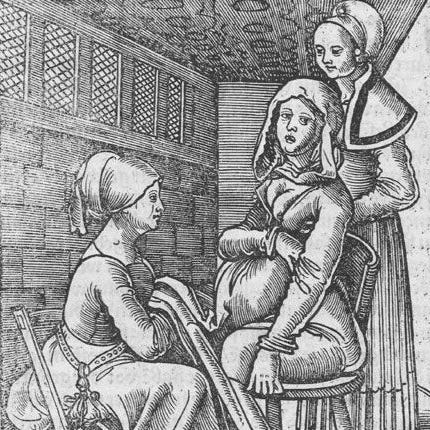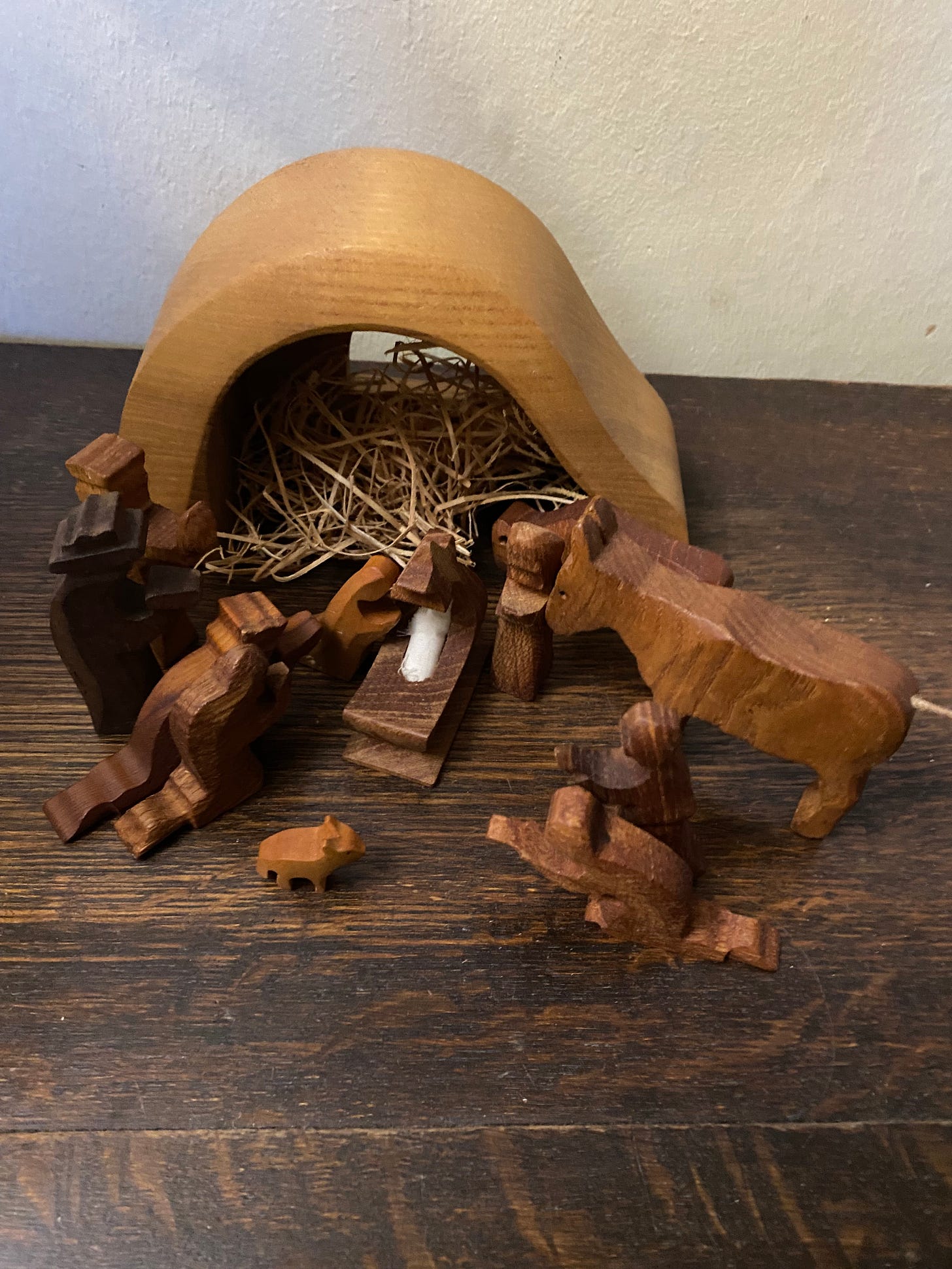Nativity, derived from the Latin nativus (meaning born or native), is usually associated with the Nativity of Christ. Christ’s birth is documented in the Gospels of Luke and Matthew, but there is little detail surrounding the actual birth itself. The story of how Jesus was born is missing. The image of Mary and Joseph kneeling at Jesus’ manger with animals and gifting Magi, is the Christian’s image of the nativity scene. Was a midwife or even a gaggle of Mary’s female friends in the stable too? Who assisted in the delivery of baby Jesus? Luke is very clear that Mary and Joseph had travelled from the city of Nazareth in Galilee to Bethlehem, or the ‘City of David’, in Judea (Luke2:4-6). There Mary delivered a baby son, Jesus. Midwives are not noted. However, the Old Testament notes the existence of a midwifery role:
And he said, When ye do the office of a midwife to the Hebrew women, and see them upon the stools; if it be a son, then ye shall kill him: but if it be a daughter, then she shall live.
(Exodus 1: 16)
Socrates (born 469 B.C.) speaks of philosophical midwifery, the sourcing of the truth that is within an individual. Socrates specified that he had attended male soul searchers as they laboured to find truth. He did not mention female soul searchers. The physical and mental exhaustion that many women are forced to endure during childbirth has been exacerbated throughout history by the lack of written accounts on the subject.
A midwife was mature in years and had usually borne children herself. She was experienced and wise: a woman of power. So, unsurprisingly during medieval times, some midwives were accused of witchcraft. Midwives were probably intelligent women, well versed in female anatomy and physiology. This would have been challenging to men without knowledge of the birthing chamber
.
In the eighteenth-century food, drink and exercise were important in the prevention of illness and aiding childbirth. Food with warming properties was thought to restore heat and dryness to a moist and cold body and provide nourishment. (Alexander Hamilton A treatise of Midwifery, 1781). Caudle, a hot drink made from a spiced or sweetened gruel mixed with wine or ale, was prepared over a fire in the birthing room during the confinement. It was drunk to fortify the mother and those involved in the delivery: a tipple for those assisting at the birth and sustenance for the mother. The recipe for caudle was passed on by word of mouth by females experienced in the obstetric business. It is worthy of note that the caudle was made in the birthing room, not the kitchen. Interestingly, the recipe is absent from manuscript collections - probably because the recipe was shared orally. The taste and scent of caudle was omnipresent at childbirth, a euphemism for labour and delivery. Caudle was also offered as hospitality to visitors after the baby’s birth.
The Midwife and the Gossips came.
With many a civil -prating Dame.
From ev’ry Parish, far and near,
With Scandal, which brings up the rear,
At Groanings, you are sure to meet,
Scandal and Caudle for the Treat
(The Humorist: being essays on several subjects; Gordon, Thomas: 1764)
The birthing room was a social place. It may be worth remembering that giving birth out of wedlock was a punishable crime. Licensed midwives swore an oath ensuring an ethical standard and were overseen by the Church. They were asked to challenge unmarried mothers regarding the baby’s father, and proof was required if the birth was stillborn (i.e. not infanticide). The midwives present provided legal protection for the mother by ensuring that the proper birthing procedures had been followed. Despite rumours of witchcraft and gossipy tongues (loosened by tipsy caudle), the birthing chamber was a supportive place. The word ‘gossip’ has its origin in the chat of the birthing room. Conversations between experienced females who, with the midwife, were invited to ‘share’ in the birth of a child. ‘Gossip’ is derived from the Old English God Sibling, God Parent or blood relative. The gossips emptied the chamber pot, offered caudle and reassuring conversation, and noted any breathing and colour changes in the mother. It was a helpful, supportive and intimate role where trust was central. One might argue that a diarist is prone to divulge the gossip of the day, but when viewed in a historical context, the information is helpful. A diary is a window snap of a given time and place: a hybrid of truth and fiction. On occasion, in the absence of a midwife, a gossip would assist in the birth of the baby. The word was used without any derogatory connotation; gossiping was a good thing. The birthing room provided a convivial atmosphere with feasting. Celebratory food also accompanied churching (post-partum mothers) and baptisms.
Samuel Johnston’s 18th century Dictionary offered three definitions of gossip:
One who answers for the child at baptism (God Parent)
A Tippling companion
One who runs about tattling like a woman at a lying in
George Eliot said “Gossip is a sort of smoke that comes from the dirty tobacco-pipes of those who diffuse it: it proves nothing but the bad taste of the smoker”. Kant’s advice was to pay no attention to gossip and Kierkegard condemned it too. These philosophers didn’t have a good word to say about idle gossip. The wartime slogan Careless Talk costs Lives, hints at unnecessary loose chat as dangerous. The bible certainly tells us that it is wrong to talk about other people and that we should concentrate on loving our neighbours as ourselves.
Thou shalt not avenge, nor bear any grudge against the children of thy people, but thou shalt love thy neighbour as thyself: I am the Lord.
(Lev 19:18)
There is a moral disdain of the gossiper and in the birthing room, gossipers formed a tight, select supportive group. This is because men were excluded from the gossiping group. The verb ‘to gossip’ has been twisted with misogynistic criticism. Gossip stemmed from a situation where women were beyond patriarchal control. Males in days of old were unable to participate in the intimate and insightful conversation of the birthing room. It was an intense situation. Fortunately, fathers today are usually central to a birthing process.
Wilkie M.S. a medical student writing in 1816 is cited in William Henderson’s 1866 collection of Northern Folklore, Notes:
Tea, duly qualified with brandy or whisky, and a profusion of shortbread and buns, are provided for all the visitors, and it is very unlucky to allow anyone to leave the house without his share of these good things.
The birthing chamber, and indeed the home, offered open, informal hospitality in the days thereafter the baby’s birth. It was a sociable place where food and drink were shared with visiting gatherings.
Margaret Baker (Folklore and Customs of Rural England) writes that Christmas Day was the luckiest day of the year on which to be born. She also mentions feasting on a Groaning or Sickening Cake, cheese and ale. The Groaning cake references the groans and sighs of a woman in labour.
There were rituals and charms to prevent evil or fairies exchanging (changeling) the baby. Highland women drank raspberry leaf tea to strengthen the muscles of the womb (Healing Threads Mary Beith), to name but one local herbal childbirth remedy. Some mothers hedged their bets by having iron in the birthing bed (Pagan) and a bible on the pillow.
It was from the flesh and blood of a woman called Mary that Jesus, the Son of God, took human form. Mary remained a virgin during parturition. Jesus was conceived through the Holy Spirit.
And knew her not till she had brought forth her firstborn son: and he called his name Jesus.
(Matt 1: 25).
The presence of the Angel in Luke’s story tells us that God intervened in human history. We hear this in Gabriel's first words to Mary: Hail, thou that art highly favoured, the Lord is with thee: blessed art thou among women. Luke 1:28 We do not read of labour pains in Matthew or Luke, nor do we see paintings of midwives and gossips enjoying caudle in Madonna and Child Nativity scenes. However, we do read in the Gospel of Luke of Mary magnificent response to being God’s chosen Galilean. She does not seek an explanation that she will bear the incarnate Son of God. Mary is accepting that the normal rules of conception do not apply. Mary was chosen for her undemanding humility, to give birth to the Christ child.
This was a paradox in that the conception was a miracle, but the birth of Jesus was human. Jesus was born as one of us, meek, mild and utterly dependent. God trusted in the love of a poor and displaced mother. A mother who gave birth in a stable without privilege or comfort: a Christmas Miracle. The submissiveness of Mary is positive, it heralds discipleship for both male and female.
Luke 1:46-55
My soul doth magnify the Lord: and my spirit hath rejoiced in God my Saviour. For he hath regarded: the lowliness of his handmaiden. For behold, from henceforth: all generations shall call me blessed. For he that is mighty hath magnified me: and holy is his Name.
Recipe for Caudle
( from Dorothy Hartley’s Food in England)
Take 2 quarts of ale, and 2 quarts of water, and add to them 2 handfuls of oatmeal (fine), 12 cloves, a nutmeg broken, and a small race of well bruised ginger root. Boil all together carefully for half an hour, stirring well. If it should work up too thick, add a little more ale (or beer,to taste). Pour it into a hot jar on to a half a pound of warm sugar and a bit of lemon in hot mugs. It should be middling strong.








Caudle seems to embody the warmth and welcome of Christmas with all the hospitality and kindness that goes with it. I am tempted to try some - and possibly offer it too 🙏😊
Really wonderful post. I had no idea of the history of gossiping, but it makes perfect sense.
Childbirth being a very specific area where the knowledge and experience of women is paramount it is unsurprising that misogynists may to denigrate the ritual, wisdom and experiences of the birthing process, castigating that which they do not understand as witchcraft.
It takes a village to raise a child, right from the start.